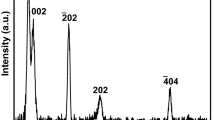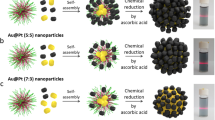Abstract
Palladium nanoparticles (Pd NPs) were fabricated by using insulin amyloid fibrils (INSAFs) as biotemplates. Atomic force microscopy measurements showed that ultra-small Pd NPs were well adsorbed and dispersed on surfaces of INSAFs. X-ray photoelectron spectroscopy confirmed the partial reduction of Pd ion into metallic Pd(0) probably due to the presence of Cys groups on surface of the insulin fibrils. The electrochemical performance of Pd/INSAFs to reduction of H2O2 was further evaluated by cyclic voltammetry. The remarkably high electrocatalytic activity, low detection limitation and excellent stability make the Pd/INSAFs a promising bio-nanoelectrocatalyst.





Similar content being viewed by others
References
C. Koenigsmann, W.P. Zhou, R.R. Adzic et al., Size-dependent enhancement of electrocatalytic performance in relatively defect-free, processed ultrathin platinum nanowires. Nano Lett. 10, 2806–2811 (2010). doi:10.1021/nl100718k
C. Li, S. Takaaki, Y. Yusuke, Electrochemical synthesis of one-dimensional mesoporous Pt nanorods using the assembly of surfactant micelles in confined space. Angew. Chem. Int. Ed. 52, 8050–8053 (2013). doi:10.1002/anie.201303035
Q.L. Wu, B. Song, Interaction of Al-induced peptide backbone ring structure with the sidechains of His, Phe, Trp and Tyr. Nucl. Sci. Tech. 26, 040504 (2015). doi:10.13538/j.1001-8042/nst.26.040504
J.D. Maeseneer, D. Egilman, W.P. Burdick et al., Enhanced electrocatalytic performance of processed, ultrathin, supported Pd–Pt core-shell nanowire catalysts for the oxygen reduction reaction. J. Am. Chem. Soc. 133, 9783–9795 (2011). doi:10.1021/ja111130t
H. Huang, D. Sun, X. Wang, PtCo alloy nanoparticles supported on graphene nanosheets with high performance for methanol oxidation. Chin. Sci. Bull. 57, 3071–3079 (2012). doi:10.1007/s11434-012-5327-4
M. Homma, S.J. Kim, Supercritical fluid synthesis and characterization of catalytic metal nanoparticles on carbon nanotubes. J. Mater. Chem. 14, 908–913 (2004). doi:10.1039/b308124a
E. Antolini, Palladium in fuel cell catalysis. Energy Environ. Sci. 2, 915–931 (2009). doi:10.1039/b820837a
N. Miyaura, A. Suzuki, Palladium-catalyzed cross-coupling reactions of organoboron compounds. Chem. Rev. 95, 2457–2483 (1995). doi:10.1021/cr00039a007
Y. Lin, X. Cui, X. Ye, Electrocatalytic reactivity for oxygen reduction of palladium-modified carbon nanotubes synthesized in supercritical fluid. Electrochem. Commun. 7, 267–274 (2005). doi:10.1016/j.elecom.2005.01.007
R. Kannan, A.R. Kim, D.J. Yoo, Synthesis, characterization and electrocatalytic studies of palladium–manganese oxyhydroxide nanocomposite towards direct ethylene glycol fuel cell. Chin. Sci. Bull. 59, 3413–3419 (2014). doi:10.1007/s11434-014-0459-3
H. Erikson, A. Sarapuu, N. Alexeyeva et al., Electrochemical reduction of oxygen on palladium nanocubes in acid and alkaline solutions. Electrochim. Acta 59, 329–335 (2012). doi:10.1016/j.electacta.2011.10.074
L. Zhang, K. Lee, J. Zhang, Effect of synthetic reducing agents on morphology and ORR activity of carbon-supported nano-Pd–Co alloy electrocatalysts. Electrochim. Acta 52, 7964–7971 (2007). doi:10.1016/j.electacta.2007.06.056
V. Mazumder, S. Sun, Oleylamine-mediated synthesis of Pd nanoparticles for catalytic formic acid oxidation. J. Am. Chem. Soc. 131, 4588–4589 (2009). doi:10.1021/ja9004915
J. Yang, Y. Xi, R. Wang et al., Synergistic effect of tungsten carbide and palladium on graphene for promoted ethanol electrooxidation. ACS Appl. Mater. Interfaces 5, 6571–6579 (2013). doi:10.1021/am401216s
B. Yoon, C.M. Wai, Microemulsion-templated synthesis of carbon nanotube-supported Pd and Rh nanoparticles for catalytic applications. J. Am. Chem. Soc. 127, 17174–17175 (2005). doi:10.1021/ja055530f
X.L. Li, Y.Q. Liu, L. Fu et al., Efficient synthesis of carbon nanotube–nanoparticle hybrids. Adv. Funct. Mater. 16, 2431–2437 (2006). doi:10.1002/adfm.200600339
K. Nguyen, M. Monteverde, A. Filoramo et al., Synthesis of thin and highly conductive DNA-based palladium nanowires. Adv. Mater. 20, 1099–1104 (2008). doi:10.1002/adma.200701803
Y.S. Nam, A.P. Magyar, D. Lee et al., Biologically templated photocatalytic nanostructures for sustained light-driven water oxidation. Nat. Nanotech. 5, 340–344 (2010). doi:10.1038/NNANO.2010.57
K.N. Avery, J.E. Schaak, R.E. Schaak, M13 bacteriophage as a biological scaffold for magnetically-recoverable metal nanowire catalysts: combining specific and nonspecific interactions to design multifunctional nanocomposites. Chem. Mater. 21, 2176–2178 (2009). doi:10.1021/cm900869u
J.H. Hou, Q.G. Du, R.B. Zhong et al., Temperature manipulating peptide self-assembly in water nanofilm. Nucl. Sci. Tech. 25, 060502 (2014). doi:10.13538/j.1001-8042/nst.25.060502
L. Zhang, N. Li, F. Gao et al., Insulin amyloid fibrils: an excellent platform for controlled synthesis of ultrathin superlong platinum nanowires with high electrocatalytic activity. J. Am. Chem. Soc. 134, 11326–11329 (2012). doi:10.1021/ja302959e
X. Zhou, L. Zheng, R. Li et al., Biotemplated fabrication of size controlled palladium nanoparticle chains. J. Mater. Chem. 22, 8862–8867 (2012). doi:10.1039/c2jm16411f
X. Zhou, Y. Wei, X. Zhao et al., Palladium nanoparticles supported by amyloid fibrils: from size controllable synthesis to extremely high catalytic performance. Colloids Surf. A 482, 416–421 (2015). doi:10.1016/j.colsurfa.2015.07.007
A.F. Lee, J.N. Naughton, Z. Liu et al., High-pressure XPS of crotyl alcohol selective oxidation over metallic and oxidized Pd (111). ACS Catal. 2, 2235–2241 (2012). doi:10.1021/cs300450y
X. Bian, K. Guo, L. Liao et al., Nanocomposites of palladium nanoparticle-loaded mesoporous carbon nanospheres for the electrochemical determination of hydrogen peroxide. Talanta 99, 256–261 (2012). doi:10.1016/j.talanta.2012.05.048
K.C. Poon, D.C. Dan, T.D. Vo et al., Newly developed stepwise electroless deposition enables a remarkably facile synthesis of highly active and stable amorphous Pd nanoparticle electrocatalysts for oxygen reduction reaction. J. Am. Chem. Soc. 136, 5217–5220 (2014). doi:10.1021/ja500275r
D. Kurouski, T. Deckert-Gaudig, V. Deckert et al., Surface characterization of insulin protofilaments and fibril polymorphs using tip-enhanced Raman spectroscopy (TERS). Biophys. J. 106, 263–271 (2014). doi:10.1016/j.bpj.2013.10.040
S.Y. Lee, J.S. Lim, M.T. Harris, Synthesis and application of virus-based hybrid nanomaterials. Biotechnol. Bioeng. 109, 16–30 (2012). doi:10.1002/bit.23328
C. Yang, C.H. Choi, C.S. Lee et al., A facile synthesis–fabrication strategy for integration of catalytically active viral-palladium nanostructures into polymeric hydrogel microparticles via replica molding. ACS Nano 7, 5032–5044 (2013). doi:10.1021/nn4005582
J. Huang, D. Wang, H. Hou et al., Electrospun palladium nanoparticle-loaded carbon nanofibers and their electrocatalytic activities towards hydrogen peroxide and NADH. Adv. Funct. Mater. 18, 441–448 (2008). doi:10.1002/adfm.200700729
W. Hong, J. Wang, E. Wang, Facile synthesis of highly active PdAu nanowire networks as self-supported electrocatalyst for ethanol electrooxidation. ACS Appl. Mater. Interfaces. 6, 9481–9487 (2014). doi:10.1021/am501859k
M.S. Ahmed, S. Jeon, Synthesis and electrocatalytic activity evaluation of nanoflower shaped Ni–Pd on alcohol oxidation reaction. J. Electrochem. Soc. 161, F1300–F1306 (2014). doi:10.1149/2.1041412jes
F. Yang, S.C. Kung, M. Cheng et al., Smaller is faster and more sensitive: the effect of wire size on the detection of hydrogen by single palladium nanowires. ACS Nano 2010(4), 5233–5244 (2010). doi:10.1021/nn101475c
Y. Liu, G. Sun, C. Jiang et al., Highly sensitive detection of hydrogen peroxide at a carbon nanotube fiber microelectrode coated with palladium nanoparticles. Microchim. Acta 181, 63–70 (2013). doi:10.1007/s00604-013-1066-8
F. Jiang, R. Yue, Y. Du et al., A one-pot ‘green’ synthesis of Pd-decorated PEDOT nanospheres for nonenzymatic hydrogen peroxide sensing. Biosens. Bioelectron. 44, 127–131 (2013). doi:10.1016/j.bios.2013.01.003
S. Momeni, I. Nabipour, A simple green synthesis of palladium nanoparticles with Sargassum alga and their electrocatalytic activities towards hydrogen peroxide. Appl. Biochem. Biotechnol. 176, 1937–1949 (2015). doi:10.1007/s12010-015-1690-3
S. Chakraborty, C.R. Retna, Electrocatalytic performance of carbon nanotube-supported palladium particles in the oxidation of formic acid and the reduction of oxygen. Carbon 48, 3242–3249 (2010). doi:10.1016/j.carbon.2010.05.014
S. Kumar, S. Zou, Electrooxidation of carbon monoxide on gold nanoparticle ensemble electrodes: effects of particle coverage. J. Phys. Chem. B. 109, 15707–15713 (2005). doi:10.1021/jp051981a
Author information
Authors and Affiliations
Corresponding author
Additional information
This work was supported by the Natural Nature Science Foundation of China (No. 11474173), the Natural Science Foundation of Zhejiang province (Nos. Y14A040006 and LQ14F040002), Ningbo Natural Science Foundation (Nos. 2014A610202 and 2014A610149) and the K. C. Wong Magna Fund of Ningbo University.
Rights and permissions
About this article
Cite this article
Kong, LX., Wang, LJ., Su, LL. et al. Amyloid fibril-supported Pd nanoparticles as electrocatalyst for hydrogen peroxide reduction. NUCL SCI TECH 27, 97 (2016). https://doi.org/10.1007/s41365-016-0098-2
Received:
Revised:
Accepted:
Published:
DOI: https://doi.org/10.1007/s41365-016-0098-2




